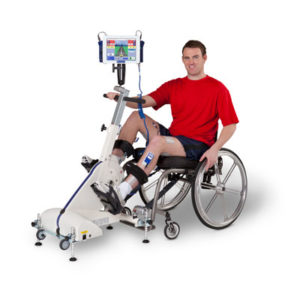Improved Hemi-Attention and Motor Return in an Individual Recovering From CVA
Neurological Rehabilitation
LAUREN GREENFELD, PT, DPT, NCS
History
Patient was a 43 y.o. diagnosed with subarachnoid hemorrhage from aneurysm, who was admitted to Shepherd Center's inpatient ABI program.
Initial Presentation
At admission, patient presented with left hemiplegia, left neglect, limited left cervical rotation passive range of motion (PROM), and difficulty following commands and answering questions. Right lower extremity strength was grossly 3/5 based on observation and left cervical rotation was limited to approximately 25% of full PROM. Patient was dependent for bed mobility, wheelchair mobility, and sitting balance. Patient required maximal assist for squat pivot transfers between bed and wheelchair but tub and toilet transfers had not been initiated due to pusher syndrome signs and safety issues. Gait was also not initiated at this time due to safety issues and need for focus on preparatory activities with midline orientation.
Treatment Progression
 During the first week of rehabilitation, neuromuscular electrical stimulation (NMES) was initiated to L knee and L wrist extensors. Contraction for L quad was noted only at high intensity. At the conclusion of week one, patient was able to perform stand pivot transfers between toilet and wheelchair with maximal assistance. Patient required maximal assistance of two people for gait with ARJO walker for eight feet.
During the first week of rehabilitation, neuromuscular electrical stimulation (NMES) was initiated to L knee and L wrist extensors. Contraction for L quad was noted only at high intensity. At the conclusion of week one, patient was able to perform stand pivot transfers between toilet and wheelchair with maximal assistance. Patient required maximal assistance of two people for gait with ARJO walker for eight feet.
During week two, functional electrical stimulation (FES) with the RT300 was implemented using electrical stimulation to the left quadriceps, hamstrings, and gluteus maximus for twenty minutes. The occupational therapist continued to use neuromuscular electrical stimulation to the left wrist extensors with the Bioness H200 unit. At the conclusion of week two, patient demonstrated improved attention to the left, including a decreased head turn preference to the left. Motor return was present in patient's left hip with 1+/5 for hip flexors and 1/5 for hip adductors. No additional contraction or movement was observed in the left lower extremity. She required less assistance for bed mobility, including requiring only moderate assistance with rolling and supine to sit and standby assistance for sitting balance. Tub bench transfers were performed with maximal assistance. Patient began pushing wheelchair with right upper and lower extremities for fifty feet with moderate assistance. Gait distance progressed to thirty feet while continuing to require maximal assistance of two people.
Week three included continued electrical stimulation to left upper and lower extremities and a focus on midline orientation. Left hip flexor strength progressed to 2+/5 and knee extensors and ankle dorsiflexors began to activate at 2+/5 and 2-/5 respectively. Bed mobility improved to a minimal assistance status. Patient performed sit to stand and squat pivot transfers to all surfaces with moderate, including toilet. Gait training against the wall with maximal assistance of two people was initiated with use of a mirror to provide visual and tactile vertical feedback. Patient was able to advance left lower extremity without assistance for the first time. After four weeks of therapy including RT300 FES and NMES to left upper extremity, muscle activation in the left lower extremity continued to improve, with hip adduction increasing to 2/5. Gait training against wall with mirror progressed to 50 feet with maximal assistance of one person. Patient carried over a similar midline gait pattern for five feet without the wall or mirror before becoming dependent. Patient propelled wheelchair 150 feet with right upper and lower extremities.
Final Presentation
At discharge, following 5 weeks of rehabilitation, patient demonstrated improved midline orientation and awareness of left side. Left cervical rotation PROM improved to 40% of full range. Patient performed gait x 150 feet with moderate assistance and verbal and tactile cues to lean to the right. Patient ascended and descended 1 flight of stairs with a step-to pattern with moderate to maximal assistance of one person with a handrail for the right upper extremity.
Assessment
From admission to discharge, the improvements in neglect/attention, pusher syndrome behaviors, and muscle activation were evident as patient improved independence level with mobility tasks. The addition of RT300 and NMES to the left extremities appeared to be factors in the improved cervical rotation, attention and sensory input driving motor return, and lower extremity activation during transfers, gait, and stairs. Patient reached the goals of negotiating stairs with assistance to allow access to patient's home and ambulating short distances with assistance to allow access inside patient's home.

